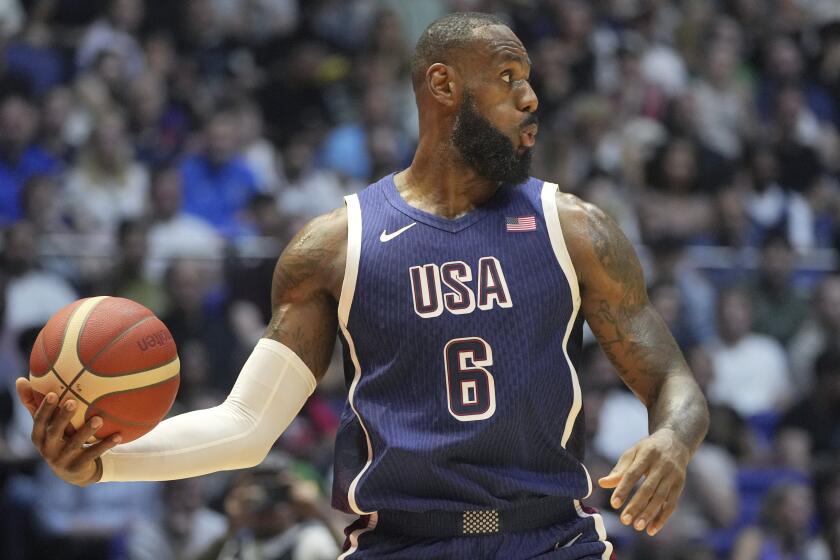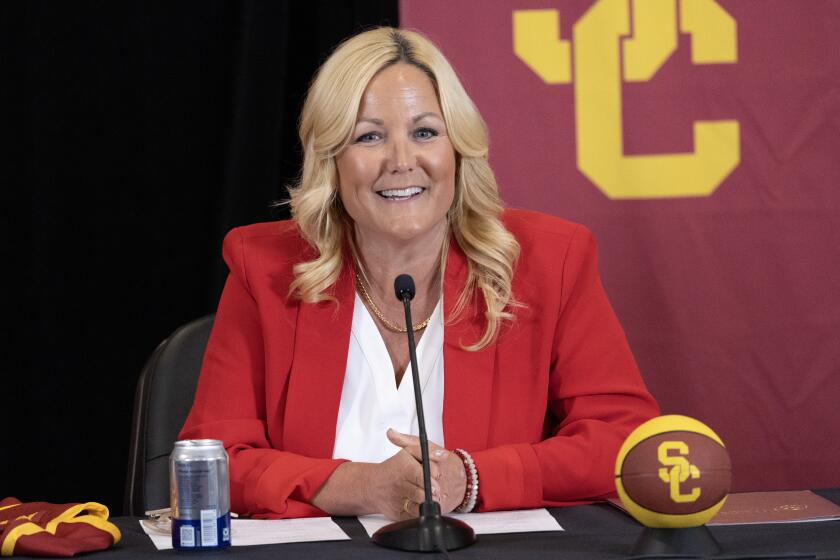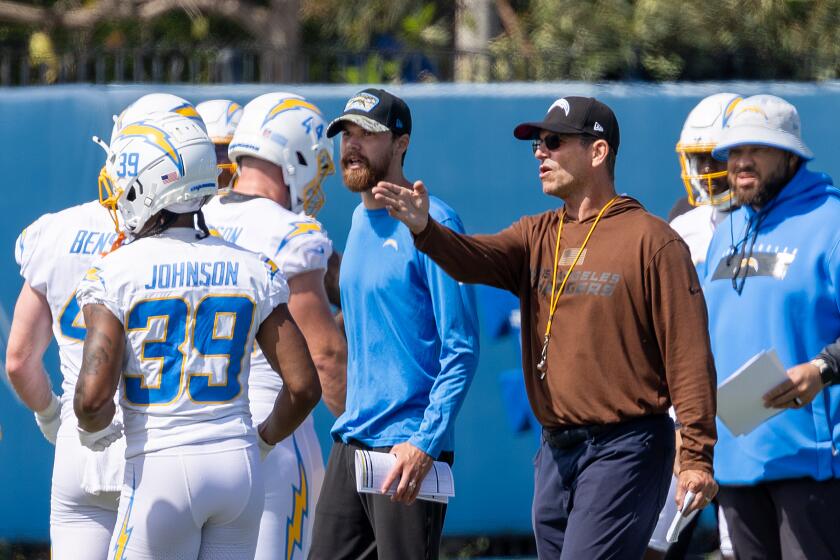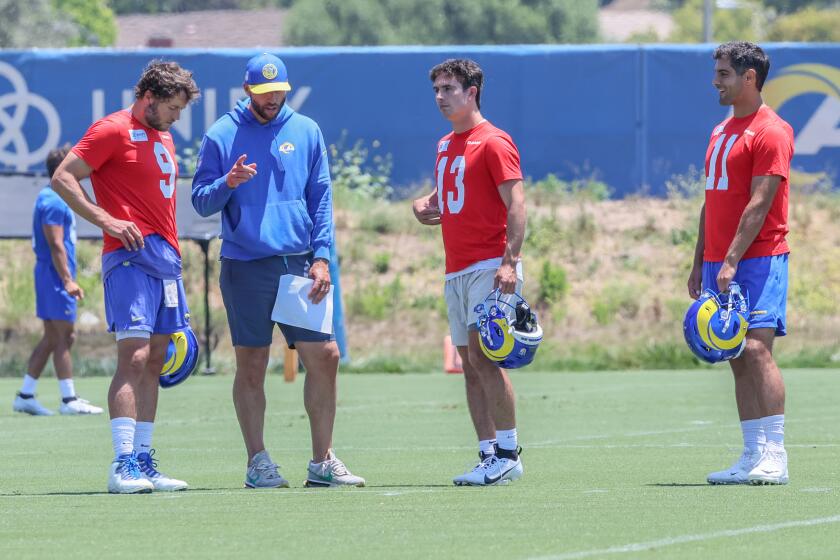Dodgers Dugout: Answering your lockout questions
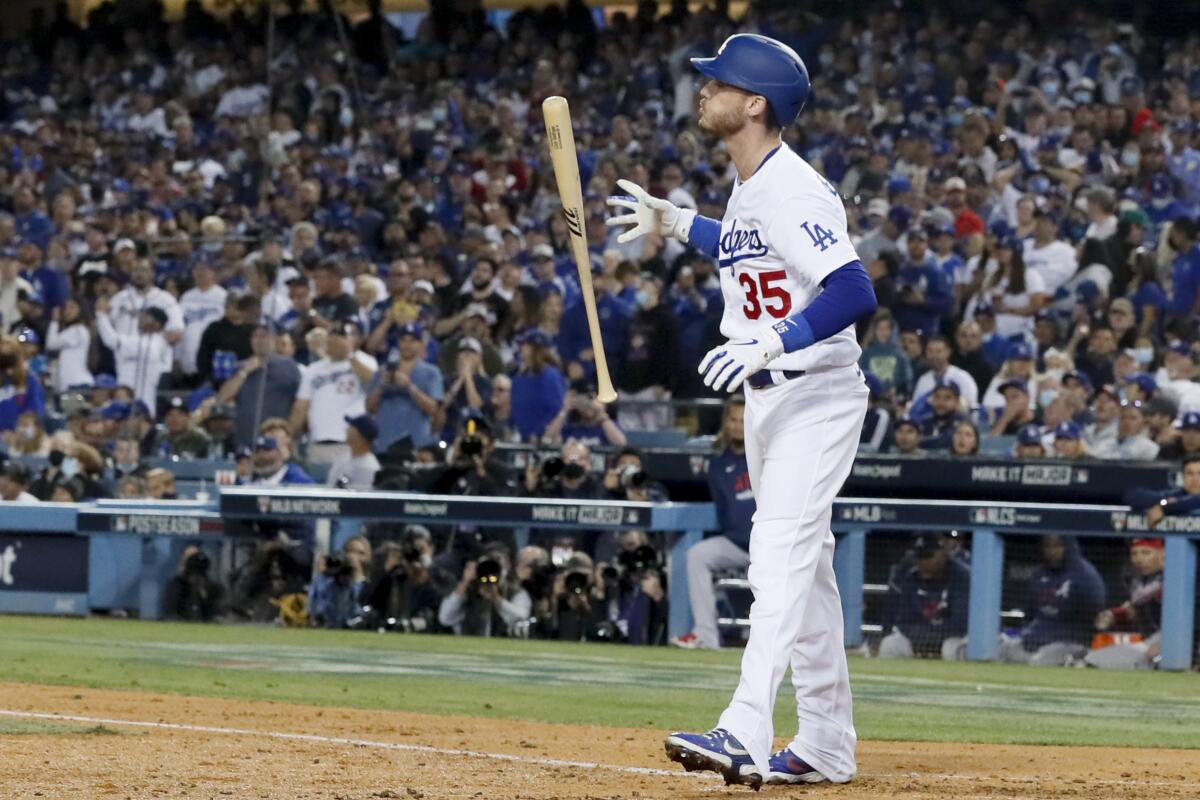
Hi, and welcome to another edition of Dodgers Dugout. My name is Houston Mitchell, and we officially begin our eighth season of this newsletter. Thanks to all of those who have subscribed.
With the lockout on, there’s no big Dodgers news. Players can’t be signed to major league contracts, so there are many free agents still out there, including Clayton Kershaw.
Are you a true-blue fan?
Get our Dodgers Dugout newsletter for insights, news and much more.
You may occasionally receive promotional content from the Los Angeles Times.
Since the lockout began, I have been flooded with questions from readers. Luckily, The Times has an expert in such matters, a guy who knows the business of baseball inside and out, who has agreed to step in and answer the most-asked questions. So, thank you to my colleague Bill Shaikin. The floor is his.
Question: What are the main sticking points of the negotiations?
Shaikin: Players: We want more of your money.
Owners: No.
Players: No, seriously. Revenues have gone up and average salaries have not. And, because analytics have taught you that you should pay players for what they will do and not for what they have done, you’re relying more on younger and cheaper players. So, if you’re so reliant on younger players, let’s pay those players more.
Owners: OK. We can take some of the money we pay older players and shift that to younger players.
Players: We want to grow the salary pie, not slice the same pie differently.
Owners: Mmmmm, pie.
(You might have heard about such issues as expanding the playoffs, fixing service time manipulation, introducing a draft lottery, and ending draft pick compensation for free agents. Proposals have been exchanged in those areas. But the owners so far have refused to discuss the primary ways the players’ union would like to get younger players paid more: making them eligible for salary arbitration and free agency sooner. The owners say the long-established benchmarks — three years to arbitration, six years to free agency, no limits on salaries in free agency — have served both sides well. Here’s more on this.)
Enjoying this newsletter?
Your support helps us deliver the news that matters most. Become a Los Angeles Times subscriber.
Q. Why such a long time between negotiations? It seems neither side is in a hurry to resolve this.
Shaikin: Deadlines bring pressure. Teams can make trades the entire month of July, for instance, but the July 31 deadline day usually results in the most trades. When the old collective bargaining agreement expired Dec. 1 without a new agreement, the immediate pressure was off. The next pressure point would appear to be the start of spring training, but the more likely pressure point would be opening day, when players would start receiving paychecks and owners would start making money from fans in the ballpark and, via television, from fans at home.
Q. I get a variation of this from a lot of readers, so let me paraphrase: “Owners are billionaires. Players are millionaires. Max Scherzer, who just signed for $43 million a year, has been a prominent voice for the players’ side. Add in the fact we suffer through a global pandemic where thousands of people lost their jobs, why should I as a fan root for either one of them, and if they cancel part of the season, why should I remain a baseball fan?”
Shaikin: Feel free to root for whomever you want, or no one at all. Most fans understandably want to hear when spring training will start, not incremental changes in proposals for what the luxury tax threshold might be. But keep in mind that many players are not millionaires: Of the players on opening day rosters last season, 46% made less than $1 million, with 35% under $600,000, according to the Associated Press.
Q. Do you think spring training and/or the season get wiped out?
Shaikin: I stand by what I wrote at the start of the lockout: “This shutdown is likely to be long. It would be a pleasant surprise if spring training started on time. It would not be a shocker if the regular season did not.”
In the last lockout, in 1990, spring training was shortened from six weeks to three, and the start of the regular season was delayed one week.
Q. Will there be a DH in the NL next season?
Shaikin: Owners and players are willing, but both sides have to agree on having a season first.
Cody Bellinger signs
In a deal that was made before the lockout but not announced until well after the lockout began, Cody Bellinger signed a one-year, $17-million deal with the Dodgers. Last year, Bellinger made $16.1 million and had the worst season of his career, batting only .165 in 95 games before rebounding to hit .353 in the postseason.
You might be saying to yourself, “How can a guy have the worst season of his career and get a raise?” That’s a good question. There are no good answers, though it’s fair to point out that Bellinger made “only” $585,000 in 2017, when he hit .267 with 39 homers and was named National League rookie of the year.
Bellinger is eligible to become a free agent after the 2023 season.
Max Scherzer speaks again
The last time we checked in with Max Scherzer, he made comments that many assumed meant he was blaming the Dodgers for his tired arm in the postseason. In an exclusive interview with The Times’ Jorge Castillo, Scherzer clarified things:
“I don’t blame the Dodgers,” Scherzer said. “Maybe I didn’t make myself clear enough in what I was actually talking about.”
Scherzer, 37, explained that he had conversations with manager Dave Roberts and others about how he would be used for the postseason. He said he spoke with Roberts after his wild-card game start against the St. Louis Cardinals — he labored through 4 1/3 innings — and told the manager he could be used out of the bullpen if needed, drawing confidence from his experience in 2019, when he helped the Washington Nationals win the World Series.
“For me, looking at how the postseason was unfolding, it looks eerily similar to what the 2019 run was for me,” Scherzer said. “I was pitching the wild-card [game] and getting into the Division Series, making a relief appearance, and then pitching in the NLCS as well. For me, there was a four-start run there. From the wild-card start — and this is 2019 — from the wild-card start to the relief appearance then two days later making a start against the Dodgers, throwing 110 pitches in that start and then continuing to start Game 2 against the Cardinals.
“That was a heavy workload for me in 2019, but I was able to do it. And so as the playoffs started, after the wild-card game, that’s when I was talking to Doc about, ‘Hey, look I have experience doing this. I understand how this postseason works. If I do get a relief appearance, you can use me out of the ‘pen.’ ”
Click here to read the entire interview.
Stories you might have missed
Dodgers add two highly regarded prospects on first day of international signings
Bill Plaschke: Dodger Stadium wedding shows progress team has made in LGBTQ community
Dodgers sign two-time Olympic medalist Eddy Alvarez to a minor league contract
Signed, sealed, delivered: How the gift of a 1963 baseball connected two Oxnard men
Andre Ethier is friendly face of nonprofit feeding struggling L.A. restaurant workers
And finally
A day in the life of Andre Ethier. Watch and listen here.
Until next time...
Have a comment or something you’d like to see in a future Dodgers newsletter? Email me at houston.mitchell@latimes.com, and follow me on Twitter at @latimeshouston. To get this newsletter in your inbox, click here.
Go beyond the scoreboard
Get the latest on L.A.'s teams in the daily Sports Report newsletter.
You may occasionally receive promotional content from the Los Angeles Times.

